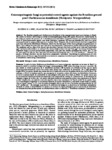Use este identificador para citar ou linkar para este item:
http://www.alice.cnptia.embrapa.br/alice/handle/doc/949274Registro completo de metadados
| Campo DC | Valor | Idioma |
|---|---|---|
| dc.contributor.author | LOPES, R. B. | pt_BR |
| dc.contributor.author | SILVA, S. D. | pt_BR |
| dc.contributor.author | TIGANO, M. S. | pt_BR |
| dc.contributor.author | BOTTON, M. | pt_BR |
| dc.date.accessioned | 2016-02-23T06:38:33Z | - |
| dc.date.available | 2016-02-23T06:38:33Z | - |
| dc.date.created | 2013-02-14 | pt_BR |
| dc.date.issued | 2012 | pt_BR |
| dc.identifier.citation | Revista Colombiana de Entomología, Santafé de Bogota, v. 38, n. 2, p. 247-251, 2012. | pt_BR |
| dc.identifier.uri | http://www.alice.cnptia.embrapa.br/alice/handle/doc/949274 | pt_BR |
| dc.description | The Brazilian ground pearl Eurhizococcus brasiliensis is the most prevalent insect pest of grapes in Brazil. The natural occurrence and biological activity of entomopathogenic fungi (EF) against this pest are poorly known. In this study, we evaluate the presence of E. brasiliensis-associated EF in soil and the virulence of a ground pearl-derived strain of Isaria fumosorosea against cysts under laboratory conditions. EF were not identified on cysts in an initial survey performed in a grape-producing area in southern Brazil. However, 6% of mobile females that had emerged from cysts were infected by Metarhizium brunneum, which was the first report of this insect pathogen on ground pearls in Brazil. Cysts without the protective wax layer were inoculated with I. fumosorosea conidia suspension by immersion. The symptoms and the signs of the disease were described. Infected cysts had a yellow-ochre color and ?hard-boiled egg? consistency when broken, in contrast to the intense bright yellow color and ?raw egg? consistency of living cysts. Vegetative fungal cells were present inside symptomatic cysts, and later, outside conidiation was visible. The LC25 for the cysts protected with the wax layer and also inoculated by immersion was 1.31 x 107 conidia·mL-1. However, the presence of fungal structures was not observed on symptomatic individuals. Considering the motionlessness of cysts and the absence of disease signs for mortality assessment, the symptoms described may be helpful for further studies on E. brasiliensis control using I. fumosorosea. | pt_BR |
| dc.language.iso | eng | eng |
| dc.rights | openAccess | eng |
| dc.subject | Pérola-da-terra | pt_BR |
| dc.title | Entomopathogenic fungi as potential control agents against the Brazilian ground pearl Eurhizococcus brasiliensis (Hemiptera: Margarodidae). | pt_BR |
| dc.type | Artigo de periódico | pt_BR |
| dc.date.updated | 2016-02-23T06:38:33Z | pt_BR |
| dc.subject.thesagro | Viticultura | pt_BR |
| dc.subject.thesagro | Uva | pt_BR |
| dc.subject.thesagro | Praga de planta | pt_BR |
| dc.subject.thesagro | Controle biológico | pt_BR |
| dc.subject.thesagro | Eurhizococcus Brasiliensis | pt_BR |
| dc.subject.nalthesaurus | Isaria fumosorosea | pt_BR |
| dc.subject.nalthesaurus | Metarhizium brunneum | pt_BR |
| riaa.ainfo.id | 949274 | pt_BR |
| riaa.ainfo.lastupdate | 2016-02-22 | pt_BR |
| dc.contributor.institution | ROGERIO BIAGGIONI LOPES, CENARGEN; SILAS DUTRA SILVA, UNB; MYRIAN SILVANA TIGANO, DE-PR; MARCOS BOTTON, CNPUV. | pt_BR |
| Aparece nas coleções: | Artigo em periódico indexado (CNPUV)  | |
Arquivos associados a este item:
| Arquivo | Descrição | Tamanho | Formato | |
|---|---|---|---|---|
| RCdE2012v38n2a14pp247251EntomopathogenicFINAL201219.pdf | 3,92 MB | Adobe PDF |  Visualizar/Abrir |









